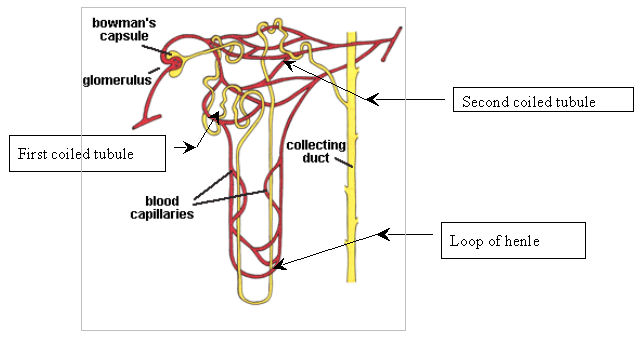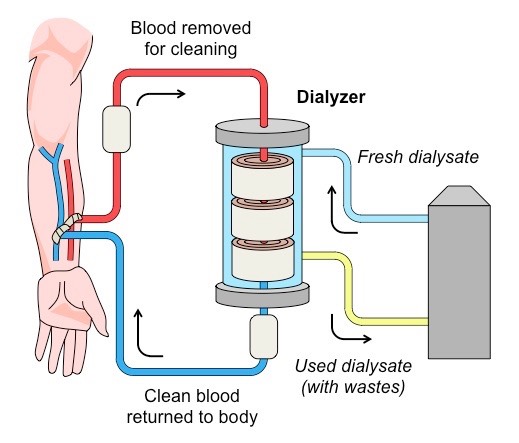Urinary System
Kidneys
The kidneys in our body are vital organs as they are needed to remove urea from the blood, control the amount of ions in the blood, and control the water content of blood. The liver produces urea, and it is also the place where proteins are broken down into fats and carbohydrates. Urea is a waste product that is filtered out of the blood as it is poisonous. Urea is produced from the breakdown of excess amino acids in the liver. The body does not need too much salt, therefore kidneys will filter out the salts when the levels are too high.
The main parts of the kidney are the medulla and the cortex. The cortex is the lighter area near the outside, while the medulla is close to the center, and it is made up of feathery like structures which are attached to the ureter.
Nephrons can be found inside the kidney, and its role is to filter the blood. Blood pressure is built up in the glomerulus - which is just a ball of capillaries, and small molecules such as water, glucose, urea and ions are forced through the Bowman’s capsule. However, bigger molecules such as the proteins and blood cells would stay put. The mixture of small molecules that has passed through has been ultra filtrated - and then it flows down the first coiled tubule, where glucose and the required salts are reabsorbed. Next it flows towards the loop of henle where water is reabsorbed. Then it flows through the second coiled tubule. Then it heads towards the collecting duct into the ureter, and finally it flows towards the bladder. The mixture should contain urea and excess ions that the body does not need.
Kidney Failure Treatment
Kidney Dialysis is when blood is taken out of a vein, and then it is pumped through a machine which would clean the blood. During the cleaning process, the machine gets rid of waste materials such as urea. The patient will then receive the clean blood without the toxic materials. However this is an expensive and time consuming treatment, and the patient has to return to the hospital quite regularly to get this done.
A kidney transplant can be used in order to help someone with a kidney failure. A donor kidney can be used to replace the original kidney that has failed. There is a relatively high success rate of around 80%, and it is vital that the tissue types that are involved with this procedure have to be the same between the donor and the patient. This is why it can take quite a long time to find the correct and appropriate donor for the patient. Patients who have kidney transplants will also require antibiotics and anti-rejection drugs for their whole life to ensure that their body does not reject the new organ, and that it can cope with the new organ.
- What do kidney transplant patients require after the surgery?
- Your answer should include: Antibiotics / Anti-Rejection / Drugs / Whole / Life / Reject / New / Organ
Explanation: Antibiotics and anti-rejection drugs for their whole life to ensure that their body does not reject the new organ, and that it can cope with the new organ. - What does ADH stand for?
- Your answer should include: Antidiuretic / Hormone
- What are kidneys needed for?
- Your answer should include: Remove / Urea / Blood / Control / Amount / Ions / Water
Explanation: To remove urea from the blood, control the amount of ions in the blood, and control the water content of blood.


